
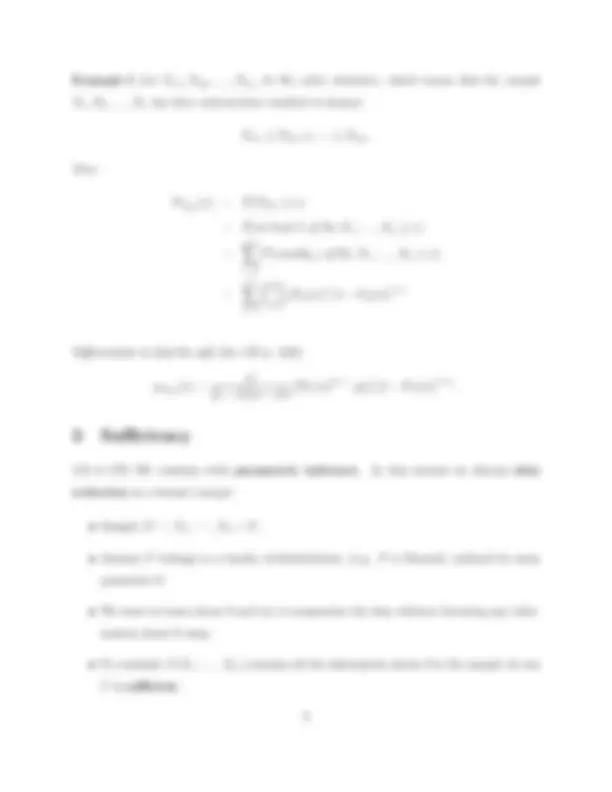
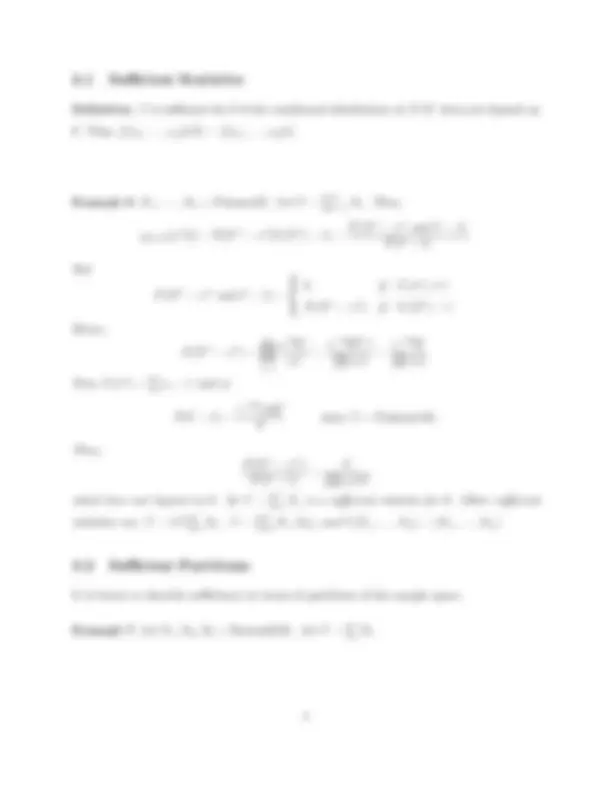
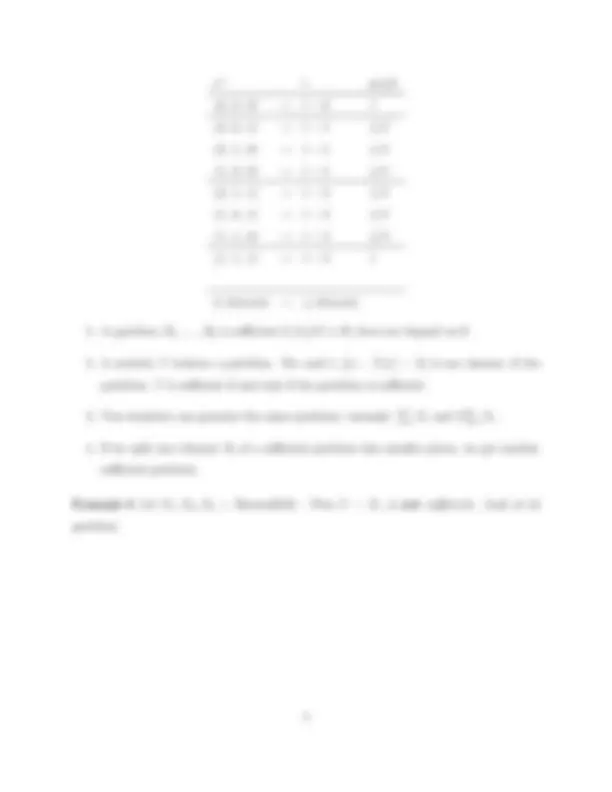
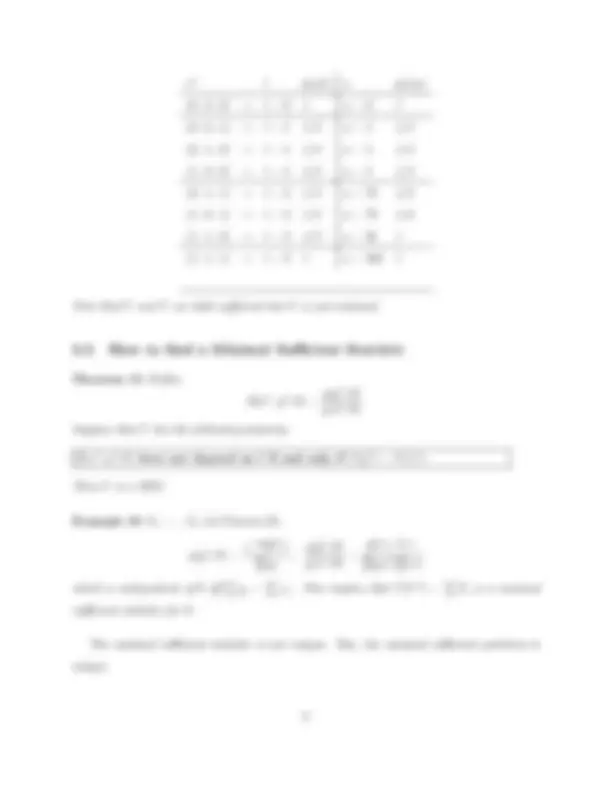
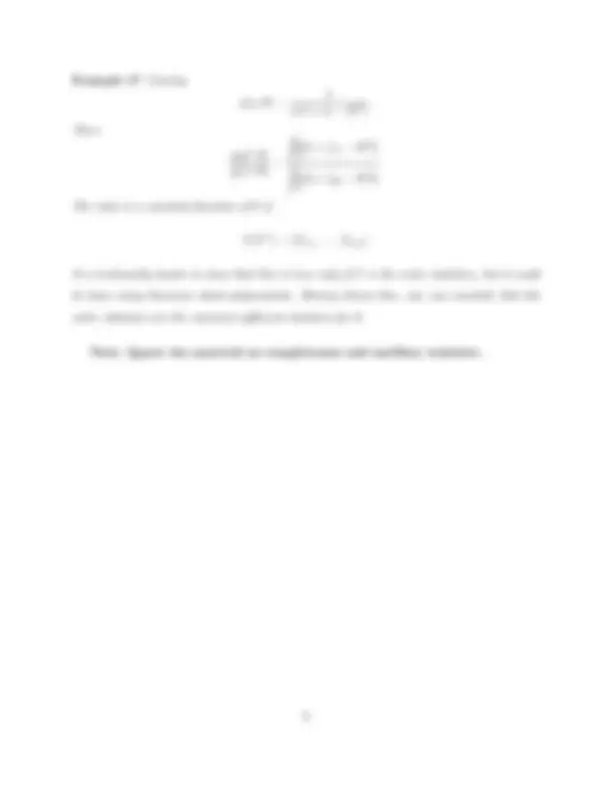


Study with the several resources on Docsity

Earn points by helping other students or get them with a premium plan


Prepare for your exams
Study with the several resources on Docsity

Earn points to download
Earn points by helping other students or get them with a premium plan
Community
Ask the community for help and clear up your study doubts
Discover the best universities in your country according to Docsity users
Free resources
Download our free guides on studying techniques, anxiety management strategies, and thesis advice from Docsity tutors
Statistical Models - Lecture Notes - Mathematics, Probability, Statistical Models, parametric model, Statistics, Sufficiency, Sufficient Statistics, Sufficient Partitions, The Factorization Theorem, Minimal Sufficient Statistic
Typology: Study notes
1 / 9

This page cannot be seen from the preview
Don't miss anything!






A statistical model P is a collection of probability distributions (or a collection of densities). An example of a nonparametric model is
P =
p :
(p′′(x))^2 dx < ∞
A parametric model has the form
P =
p(x; θ) : θ ∈ Θ
where Θ ⊂ Rd. An example is the set of Normal densities {p(x; θ) = (2π)−^1 /^2 e−(x−θ)^2 /^2 }. For now, we focus on parametric models. The model comes from assumptions. Some examples:
These models are not correct. But they might be useful. Later we consider nonpara- metric methods that do not assume a parametric model
Let X 1 ,... , Xn ∼ p(x; θ). Let Xn^ ≡ (X 1 ,... , Xn). Any function T = T (X 1 ,... , Xn) is itself a random variable which we will call a statistic. Some examples are:
Example 1 If X 1 ,... , Xn ∼ Γ(α, β), then X ∼ Γ(nα, β/n). Proof:
MX = E[etx] = E[e P (^) Xit/n ] =
i
E[eXi(t/n)]
= [MX (t/n)]n^ =
1 − βt/n
1 − β/nt
]nα .
This is the mgf of Γ(nα, β/n).
Example 2 If X 1 ,... , Xn ∼ N (μ, σ^2 ) then X ∼ N (μ, σ^2 /n).
Example 3 If X 1 ,... , Xn iid Cauchy(0,1),
p(x) = (^) π(1 +^1 x (^2) )
for x ∈ R, then X ∼ Cauchy(0,1).
Example 4 If X 1 ,... , Xn ∼ N (μ, σ^2 ) then
(n − 1) σ^2 S
(^2) ∼ χ (^2) (n−1).
The proof is based on the mgf.
Definition: T is sufficient for θ if the conditional distribution of Xn|T does not depend on θ. Thus, f (x 1 ,... , xn|t; θ) = f (x 1 ,... , xn|t).
Example 6 X 1 , · · · , Xn ∼ Poisson(θ). Let T = ∑ni=1 Xi. Then,
pXn|T (xn|t) = P(Xn^ = xn|T (Xn) = t) = P^ (X
n (^) = xn (^) and T = t) P (T = t).
But
P (Xn^ = xn^ and T = t) =
0 if T (xn) 6 = t P (Xn^ = xn) if T (Xn) = t Hence, P (Xn^ = xn) =
∏^ n i=
e−θθxi xi! =^
e−nθθ P (^) xi ∏(x i!)^ =^ ∏e−nθθt (xi!). Now, T (xn) = ∑^ xi = t and so
P (T = t) = e
−nθ(nθ)t t! since^ T^ ∼^ Poisson(nθ).
Thus, P (Xn^ = xn) P (T = t) =^
t! (∏^ xi)!nt which does not depend on θ. So T = ∑ i Xi is a sufficient statistic for θ. Other sufficient statistics are: T = 3. 7 ∑ i Xi, T = (∑ i Xi, X 4 ), and T (X 1 ,... , Xn) = (X 1 ,... , Xn).
It is better to describe sufficiency in terms of partitions of the sample space.
Example 7 Let X 1 , X 2 , X 3 ∼ Bernoulli(θ). Let T = ∑^ Xi.
xn^ t p(x|t) (0, 0, 0) → t = 0 1 (0, 0, 1) → t = 1 1/ (0, 1, 0) → t = 1 1/ (1, 0, 0) → t = 1 1/ (0, 1, 1) → t = 2 1/ (1, 0, 1) → t = 2 1/ (1, 1, 0) → t = 2 1/ (1, 1, 1) → t = 3 1
8 elements → 4 elements
Example 8 Let X 1 , X 2 , X 3 ∼ Bernoulli(θ). Then T = X 1 is not sufficient. Look at its partition:
We want the greatest reduction in dimension.
Example 12 X 1 , · · · , Xn ∼ N (0, σ^2 ). Some sufficient statistics are:
T (X 1 , · · · , Xn) = (X 1 , · · · , Xn) T (X 1 , · · · , Xn) = (X 12 , · · · , X^2 n) T (X 1 , · · · , Xn) =
( (^) ∑m
i=
X i^2 , ∑^ n i=m+
X i^2
T (X 1 , · · · , Xn) =
X i^2.
Definition: T is a Minimal Sufficient Statistic if the following two statements are true:
Suppose U is sufficient. Suppose T = H(U ) is also sufficient. T provides greater reduction than U unless H is a 1 − 1 transformation, in which case T and U are equivalent.
Example 13 X ∼ N (0, σ^2 ). X is sufficient. |X| is sufficient. |X| is MSS. So are X^2 , X^4 , eX^2.
Example 14 Let X 1 , X 2 , X 3 ∼ Bernoulli(θ). Let T = ∑^ Xi.
xn^ t p(x|t) u p(x|u) (0, 0, 0) → t = 0 1 u = 0 1 (0, 0, 1) → t = 1 1/3 u = 1 1/ (0, 1, 0) → t = 1 1/3 u = 1 1/ (1, 0, 0) → t = 1 1/3 u = 1 1/ (0, 1, 1) → t = 2 1/3 u = 73 1/ (1, 0, 1) → t = 2 1/3 u = 73 1/ (1, 1, 0) → t = 2 1/3 u = 91 1 (1, 1, 1) → t = 3 1 u = 103 1
Note that U and T are both sufficient but U is not minimal.
Theorem 15 Define R(xn, yn; θ) = p(y
n; θ) p(xn; θ). Suppose that T has the following property:
R(xn, yn; θ) does not depend on θ if and only if T (yn) = T (xn).
Then T is a MSS.
Example 16 Y 1 , · · · , Yn iid Poisson (θ).
p(yn; θ) = e
−nθθP^ yi ∏ (^) y i^ ,^
p(yn; θ) p(xn; θ) =^ ∏θP yi−P^ xi yi!/ ∏^ xi!
which is independent of θ iff ∑^ yi = ∑^ xi. This implies that T (Y n) = ∑^ Yi is a minimal sufficient statistic for θ.
The minimal sufficient statistic is not unique. But, the minimal sufficient partition is unique.